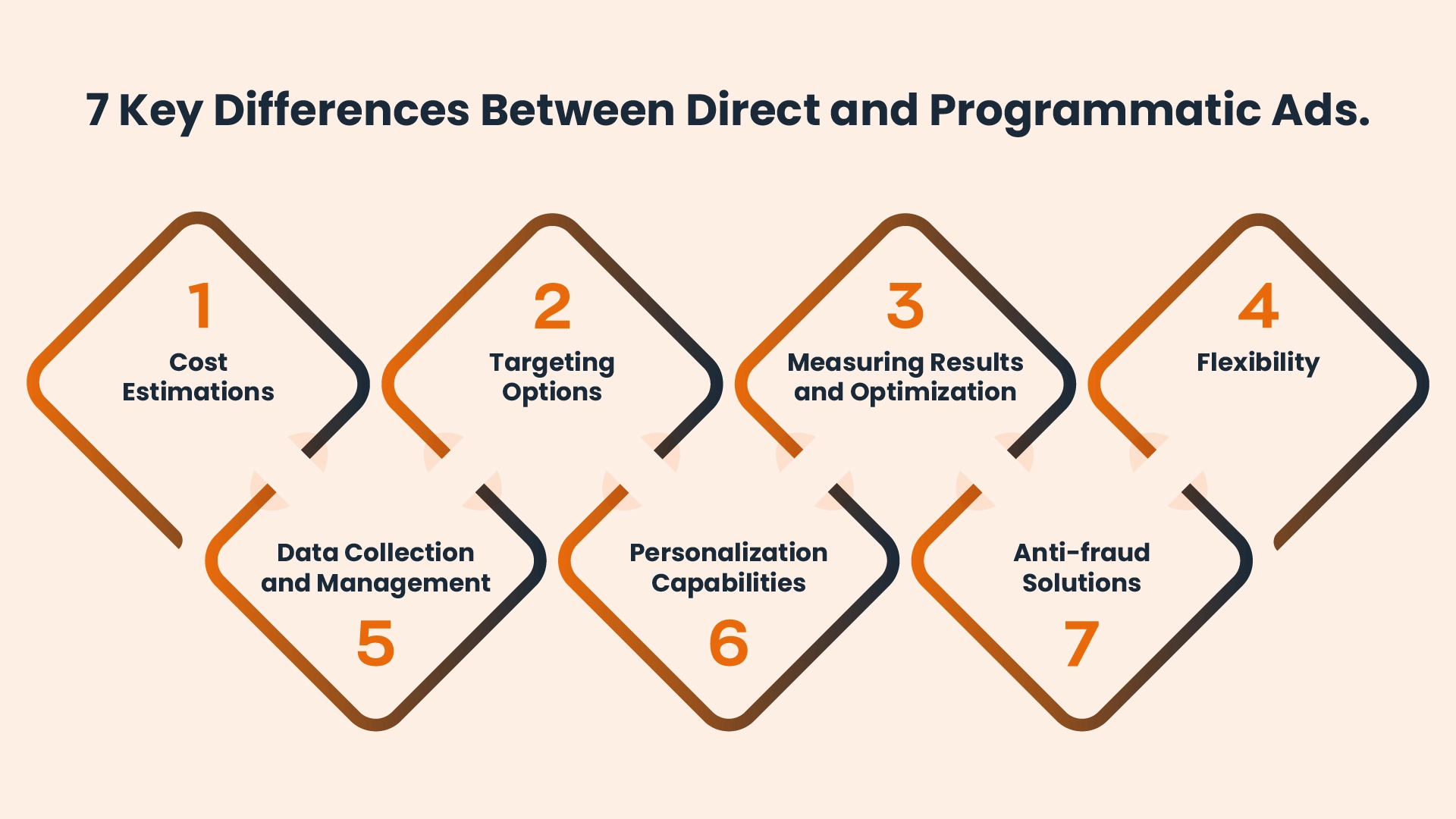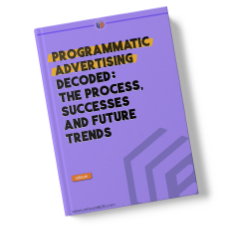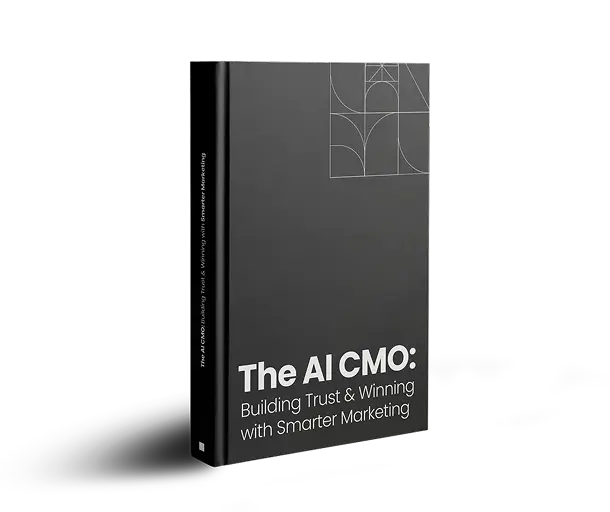
Programmatic Advertising seems to be catching fire lately with everyone saying it’s the future of marketing. Paid marketing in general, has seen a growth in accurate targeting and optimization. Leading us all to believe the statement I just made earlier. But why programmatic advertising? Shouldn’t direct ads work the same? This article aims to answer these questions about direct vs. programmatic ads.
But first, let’s see how these work.
Understanding the Media Buying Process
Advertising begins with media buying. To show your ads to relevant users, you need access to digital spaces and ad inventories. And, media buying is the process for buying and selling digital ad spaces. It is also the main factor that differentiates direct vs. programmatic ads.
Media Buying for Programmatic Ads
Programmatic advertising automates the buying and selling of ad space. The exchange happens based on bidding systems that include multiple advertisers and publishers. These bidding systems are also known as programmatic media buying types. Unlike direct media buying, programmatic media buying is not guaranteed. Only the highest bidder wins the ad spaces. Since this process is automated, there are several platforms that work in tandem to make it happen.
Media Buying for Direct Ads
Media buying for direct ads includes an agreement between a publisher and an advertiser. In this process, both parties negotiate the terms of the agreement. These include the price, number of displayed ads, target location, and duration of the ad. These are guaranteed deals that do not include any other bidders.
Apart from the media buying process, there are 7 other differences between direct and programmatic ads.
7 Key Differences Between Direct and Programmatic Ads
- Cost Estimations
- Data Collection and Management
- Targeting Options
- Personalization Capabilities
- Measuring Results and Optimization
- Anti-fraud Solutions
- Flexibility

1. Cost Estimations
As discussed earlier, programmatic media buying has different types which dictate the payment model. For real-time bidding, the highest bidder wins in an open auction. For private marketplaces, it is the same, but on a smaller scale. So, cost is usually determined by factors like your competitors and the value determined by the keywords.
On the other hand, direct ads involve bulk purchases directly from the publisher. This means that the prices have a fixed CPM, which is a huge advantage for advertisers and publishers.
2. Data Collection and Management
Data plays a crucial role in advertising. You determine your target audience, ad copies, and results based on the data you collect.
In programmatic media buying, advertisers and publishers use data management platforms to gather, organize, and save data about the users and the campaigns. This goes a long way to help both parties make better decisions during, and even after the campaigns are over.
Direct ads don’t have any data integration capacity, so you can’t collect any of it. You can only rely on the publisher’s data (if they agree to give it to you) or third-party data that is publicly available.
3. Targeting Options
The best part about advertising in 2023 is the comprehensive targeting options.
With direct ads, you rely on the publisher to attract a certain specific audience that you are interested in or who can be beneficial to you. The targeted ads are not custom-made as per user interests or needs.
Programmatic ads have different targeting options that advertisers use as per requirement. These targeting options include demographic, contextual, remarketing, geotargeting, and behavioral targeting. So for direct vs. programmatic ads, the latter is easily the better option to target the audience you want.
4. Personalization Capabilities
Making the right use of your ad spend is to ensure that your audience connects with the ad. So, personalization becomes an important aspect of your campaigns.
Programmatic ads have high personalization capabilities. Marketers can create tailored messages based on the websites users visit. They can also create ads and campaigns taking into consideration the location, demographics, interest, and user actions.
Direct ads have limited personalization as they can rely on the user data or audience details provided by the publisher. This limits the opportunity to create ads and campaigns based on user data.
5. Measuring Results and Optimization
There’s a very low chance of businesses nailing paid marketing on their first go. But, to avoid repeating that, they need to analyze the results and optimize their campaigns on the go or for the next campaign to meet your KPIs.
Programmatic advertising platforms include real-time updates and results for advertisers. This allows them to perform optimization on any level of the campaign from start to end
With direct ads, you do not have control over the campaigns. So, you can’t measure the results or optimize the campaigns, while they’re running. This holds it back and may not be the best option for advertisers.
6. Anti-fraud Solutions
Whether it’s direct ads or programmatic ads, both are prone to ad fraud. With direct ads, your options for anti-fraud solutions are very limited. But, the chances of ad fraud are also less as you directly deal with the other party. So threats like fake traffic and data are the only ones you need to worry about.
But, for programmatic ads, you can potentially be a victim of frauds like misrepresented inventory in addition to fake traffic and data. If you’re a publisher, you can face fraud threats like non-brand safe creatives and data fraud. To tackle this, programmatic platforms evolve and integrate solutions that keep your campaigns safe.
This makes direct ads, just a little safer because of a lower chance for fraud.
7. Flexibility
Flexibility in advertising can mean many different things. The flexibility to adjust your targeting options, the flexibility of the cost for impressions, etc.
Programmatic ads are flexible in every aspect. The cost of selling ads is dependent on the bidders. Targeting options enable you to reach any specific audience you’d like. And, the result parameters can also be adjusted.
But when it comes to direct ads, flexibility is limited as there is less targeting, lack of personalization, and optimization is just not possible during the campaign.
Direct vs. Programmatic Advertising – Which One’s Better and When to Use Them?
After learning about 7 key differences and the different media buying processes, you’ve probably figured it out already. Both, direct and programmatic ads have their own strengths and weaknesses. But, direct ads seem to have it a little worse than programmatic.
Programmatic has multiple benefits like convenience, options for targeting, flexibility, and anti-fraud solutions. The adaptability becomes even higher when you don’t have any websites you would like to present your ad to. Direct ads on the contrary have various limitations.
Publishers can usually benefit more from direct ads. With a distinct reader base, they can look for opportunities to implement direct ads that are contextual. The contextual approach is benefiting for more focused audiences. Often these websites have unique subdomains or sections that target different audience segments. Publishers also get to set the cost and terms while selling their ad space, unlike the uncertainty of programmatic advertising.
With all of these varying benefits, the best course of action is to use both of them together. Having the reliability of direct ads can help you maintain a decent inflow of users, while programmatic ads can help you diversify your sources of attracting visitors.
The same goes for publishers. If you can find a reliable advertiser and determine a cost that works well for you, direct ads make total sense. But, having programmatic ads as a backup can ensure that your ad spaces will always have a bidder and by extension, revenue.
So, direct vs. programmatic ads is more about understanding how to use them in tandem, rather than only choosing one.
Understanding Programmatic Advertising
Programmatic advertising isn’t a new concept by any means. But, it is only starting to get the level of hype around it that it deserves. If you’re new to the concept, you have to level up your game and stay on top of the programmatic advertising train. To get started, read our blog: Beginner’s Guide to Programmatic Advertising.
If you want to learn about real-time case studies and future trends in programmatic advertising, do not forget to check out UnboundB2B’s programmatic advertising ebook for free.

Our blog
Latest blog posts
Tool and strategies modern teams need to help their companies grow.

Our definition of marketing success in B2B is evolving. For years, traditional metric...

Video has emerged as one of the most effective tools to cut through the noise and con...

The way B2B buyers research, engage, and decide has changed and so must the way marke...






